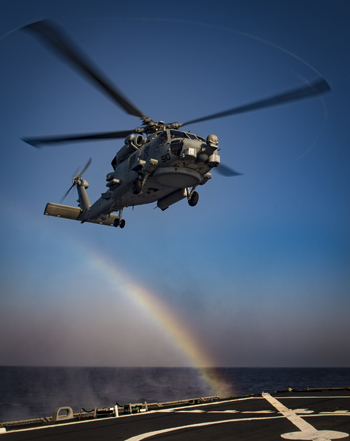INDIAN ARMED FORCES CHIEFS ON OUR RELENTLESS AND FOCUSED PUBLISHING EFFORTS

The insightful articles, inspiring narrations and analytical perspectives presented by the Editorial Team, establish an alluring connect with the reader. My compliments and best wishes to SP Guide Publications.

"Over the past 60 years, the growth of SP Guide Publications has mirrored the rising stature of Indian Navy. Its well-researched and informative magazines on Defence and Aerospace sector have served to shape an educated opinion of our military personnel, policy makers and the public alike. I wish SP's Publication team continued success, fair winds and following seas in all future endeavour!"

Since, its inception in 1964, SP Guide Publications has consistently demonstrated commitment to high-quality journalism in the aerospace and defence sectors, earning a well-deserved reputation as Asia's largest media house in this domain. I wish SP Guide Publications continued success in its pursuit of excellence.
MH-60R Seahawk Helicopters for Navy
 |
The Author is Former Director General of Information Systems and A Special Forces Veteran, Indian Army |

The US has approved the sale of 24 multi-role MH-60R Seahawk helicopters, armed with Hellfire missiles, MK-54 torpedoes and precision-kill rockets to India at estimated cost of $2.6 billion, the Trump administration has notified the Congress. A statement by the US State Department approved the sale of 24 MH-60s and affiliated equipment including state-of-the-art sensors, communication systems and weapons systems, saying. "This proposed sale will support the foreign policy and national security of the United States by helping to strengthen the US-Indian strategic relationship and to improve the security of a major defensive partner which continues to be an important force for political stability, peace and economic progress in the Indo-Pacific and South Asia region." As per US laws, the Congress is required to approve the sale. The actual deal is likely to be signed by September this year. The Navy, which is currently operating nearly 140 ships and submarines, urgently needs to replace the 16 ageing British-made Sea King helicopters which began induction 48 years back in 1971 for the aircraft carrier, INS Vikrant. These Sea Kings have remained the primary anti-submarine helicopters, designed to detect enemy submarines and, if necessary, to take them out using torpedoes. Maintaining the Sea King helicopters has been a nightmare over the last decade. With scarce availability of parts, only a handful of these helicopters remain operational.
Designed for hunting submarines as well as knocking out ships and conducting search-and-rescue operations at sea, the Seahawk helicopters will replace the ageing British-made Sea King helicopters. These Seahawk helicopters would boost the Indian Navy's anti-surface and anti-submarine warfare operations as China expands its presence in the Indian Ocean. China's consolidation in the Indian Ocean is progressing at full speed. Chinese presence in Gwadar, together with the proposed China-Pakistan joint base in Jiwani and Pakistani ports of Pasni and Karachi linked to CPEC gives the PLA access to entire Pakistan coast line. In addition to Chinese takeover of the Hambantota Port in Sri Lanka for 99 years, the Chinese ambassador to Sri Lanka with a high level delegation made a detailed survey of the land tracts around Kankesanthurai Harbour and Palaly international airport of Sri Lanka during March 2019. This is likely a prelude to Chinese investments in these areas to enhance its monitoring of the Indian Ocean, including the stretch from Kanyakumari to Visakhapatnam. The MH-60R Seahawk are currently deployed with the US Navy as the primary submarine warfare and anti-surface weapon system for open ocean and littoral zones. They are designed to operate from frigates, destroyers, cruisers and aircraft carriers. According to the US Naval Air Systems Command, the MH-60R Seahawk missions include anti-submarine warfare, anti-surface warfare, surveillance, communcations relay, combat search and rescue, naval gunfire support and logistics support.
The MH-60R Seahawks is the first Indo-US defence deal after the two countries in September 2018 signed the Communications Compatibility and Security Agreement (COMCASA); one of the foundational agreements that US wanted New Delhi to sign in order to set the ground for the transfer of high-tech US military equipment. The MH-60R being procured are fully compatible with American warships, drones and submarines. This will be an added advantage in the Indo-US joint naval exercises and future manoeuvres, when required. The intriguing issue has been India procuring very limited quantities of weaponry with the Seahawk helicopters. For example, India is procuring only 30 x Mk-54 torpedoes to go with the helicopters even though the primary role of these helicopters is anti-submarine warfare. Similarly, the Navy has acquired 'inert' training rounds of the Naval Strike Missile without actually procuring the missile itself. The Naval Strike Missile (NSM) is designed to hit targets such as ships more than 180 km away. This could imply another deal subsequently or mounting of indigenous weapons. For example as per earlier reports, the P-8I Poseidon aircraft of our Navy lacked sonobuoys, 360°coverage, and advanced sensor package. The French Scorpene class submarines lacked torpedoes as the Italian company Finmeccanica was blacklisted due to the AgustaWestland scam, and are currently dependent on missiles to protect itself or attack the enemy. Similarly, many of Indian destroyers and frigates lacked towed array sonar. All this indicates a poor state of defence planning. The Seahawks acquisition no doubt will boost the Navy's capabilities. However, ultimately the answer lies in indigenous production of defence equipment. Just like HAL Dhruv helicopter's design was utilised to develop the Light Combat Helicopter (LCH), a similar thing can be done with Medium Lift Helicopter (MLH) and Light Utility Helicopter (LUH), for which HAL and private industry must join hands. India can't afford to keep importing weapon platforms and defence equipment in perpetuity.





